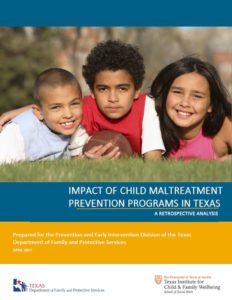Impact of Child Maltreatment Prevention Programs in Texas: A retrospective analysis
 For the first time ever, we can begin to show the long-term effectiveness of Texas child maltreatment prevention programs.
For the first time ever, we can begin to show the long-term effectiveness of Texas child maltreatment prevention programs.
As part of the Project HOPES Evaluation, the Texas Institute for Child & Family Wellbeing (TXICFW) partnered with Texas DFPS Prevention and Early Intervention division to explore the impact of child maltreatment prevention programs in Texas.
This report addresses three primary questions:
- What portion of families who receive prevention services later have a substantiated child maltreatment case?
- Which programs appear to reduce child maltreatment?
- Which family characteristics and program screening tools predict child maltreatment?
In this analysis, TXICFW researchers gathered data from a total of 137,068 caregivers who received services from 2008 to 2015 across 253 of the 254 Texas counties and matched them with CPS case records. Of these caregivers, 97 percent did not have a subsequent substantiated case of child maltreatment.
Findings suggest families with certain risk factors have higher rates of maltreatment. These characteristics include a low annual income, younger parents, unmarried parents, unhoused families, and isolated parents. While these factors are commonly associated with child maltreatment, our findings suggest that the combination of these factors increases the likelihood of a substantiated maltreatment case among families receiving prevention services. Thus, prevention services should target family units with a combinations of risk factors rather than focus on single risk factors.
